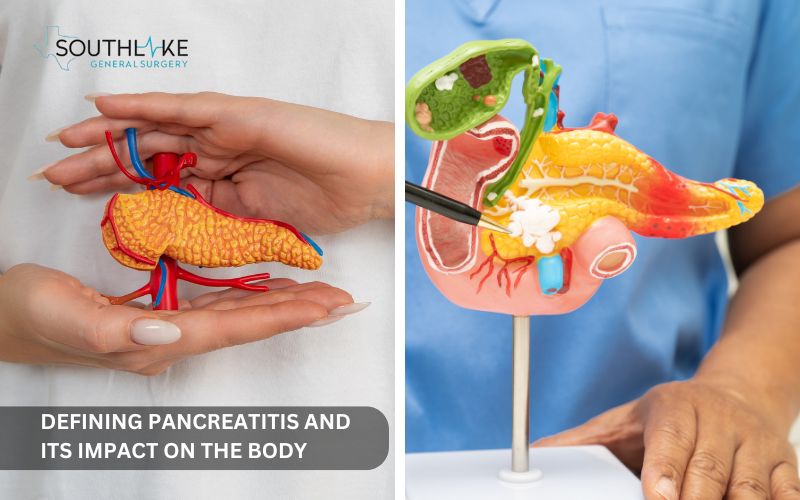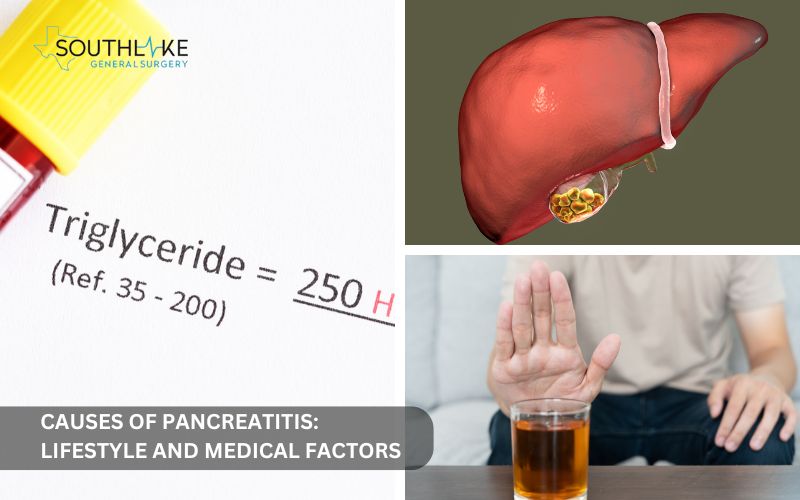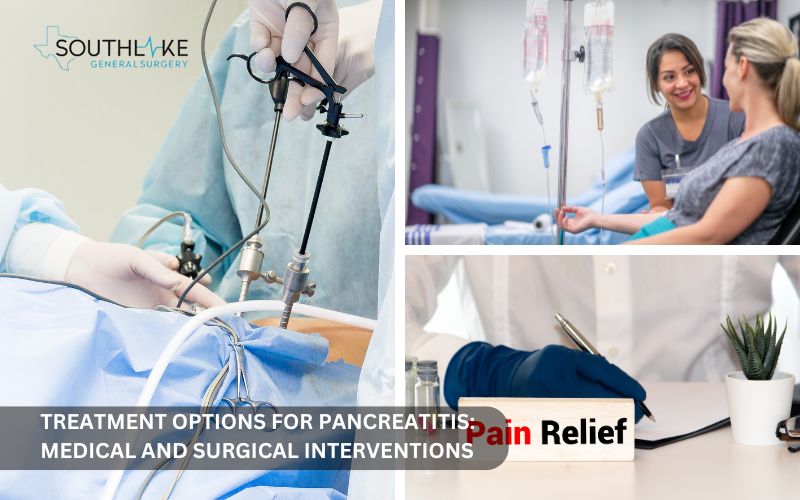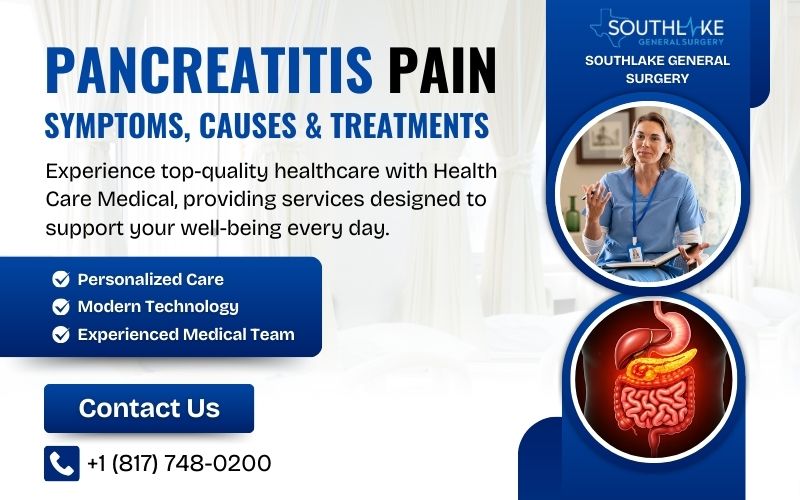Pancreatitis pain is a strong inflammation of the pancreas. The pancreas is key for digestion and helps manage blood sugar levels. This condition can cause sharp pain in the upper belly. Sometimes, the pain can spread to the back, causing much discomfort and distress for those who feel it.
Key Highlights
- Pancreatitis is a painful swelling of the pancreas. This small organ is important for digestion and blood sugar control.
- The pain is usually felt in the upper belly and may spread to the back.
- There are two main types of pancreatitis: acute, which happens suddenly and lasts for a short time, and chronic, which can last longer.
- Common causes of this condition include gallstones, heavy alcohol use, high triglycerides, and some medications.
- Treatment depends on the type and how severe it is. This can involve managing the pain or even surgery.
Understanding Pancreatitis Pain
Pancreatitis pain can feel very strong and tough to deal with. It usually begins in the upper stomach and goes to the back. People may feel like something is very wrong.
The way pancreatitis shows up can change how you feel the pain and how long it lasts. It’s important to take this pain seriously. It might mean there is a problem with a key organ that helps with digestion and blood sugar.
Knowing the type of pain can help you get medical help fast. This can prevent more issues from happening later.
Defining Pancreatitis and Its Impact on the Body

Pancreatitis is when the pancreas becomes swollen. This swelling impacts its important functions. The pancreas is located behind the stomach. It generates enzymes that facilitate the breakdown of food and hormones such as insulin that control blood glucose levels.
When the pancreas swells, its own digestive enzymes can harm it. This can lead to trouble digesting food and keeping blood sugar levels in check.
Differentiating Between Acute and Chronic Pancreatitis
Understanding the difference between acute pancreatitis and chronic pancreatitis is important. This will help you choose the right treatment and understand what can happen in the long run.
Acute pancreatitis starts quickly and causes intense pain. With good medical care, it usually gets better in a few days. But sometimes, acute pancreatitis can become very serious and lead to complications.
Chronic pancreatitis develops over time and lasts a long time. People with chronic pancreatitis may have episodes of acute pancreatitis. These episodes can harm the pancreas even further. The ongoing inflammation can lead to permanent damage as well.
Identifying the Symptoms of Pancreatitis
It is very important to know the symptoms of pancreatitis early. This helps you get medical care fast and manage your condition better. Acute pancreatitis and chronic pancreatitis have similar signs, but they feel different.
By knowing these differences, you can see a doctor sooner. This lowers the chance of complications. A quick diagnosis and treatment are key for better results with pancreatitis.
Early Signs of Pancreatitis Pain
Acute pancreatitis usually starts with sudden and strong pain in the upper stomach. This pain can spread to the back and may feel like stabbing or burning. In addition to this severe abdominal pain, there are other symptoms of acute pancreatitis:
- Nausea
- Vomiting
- Fast pulse
These symptoms occur when the pancreas gets swollen and releases digestive enzymes. These enzymes can harm nearby tissues and organs. It is important to notice these early signs. Getting medical help quickly can make a big difference for acute pancreatitis.
Recognizing Chronic Pancreatitis Symptoms
Chronic pancreatitis develops more gradually than acute pancreatitis.
- The pain is usually in the upper part of the stomach.
- The pain can feel constant or it may come and go.
- It might feel worse after eating.
- People with chronic pancreatitis often lose weight even if they don’t try to. This is because their damaged pancreas can’t create enough digestive enzymes.
- Food can be hard to absorb because of the lack of these enzymes.
- Chronic pancreatitis can also lead to diabetes. This occurs because it harms the cells in the pancreas that produce insulin.
Exploring the Causes of Pancreatitis

Understanding pancreatitis is crucial for preventing it. This condition can happen suddenly or last a long time. We may not be able to change genetic factors, but we can change our lifestyle choices.
For example, we can think about our alcohol consumption and the issue of gallstones. By focusing on these factors, we can reduce the chance of getting pancreatitis. It’s smart to discuss your personal risk factors and prevention tips with your healthcare provider.
Factors Leading to Acute Pancreatitis
Gallstone pancreatitis is a common reason for acute pancreatitis. It happens when gallstones block the pancreatic duct. This blockage stops digestive enzymes from flowing, causing inflammation.
- Drinking too much alcohol is a major cause of acute pancreatitis, but we aren’t sure why.
- Certain drugs can also cause acute pancreatitis. Medications for HIV/AIDS, autoimmune diseases, and some mental health disorders may cause swelling in the pancreas.
- A high level of triglycerides in the blood can lead to acute pancreatitis.
- It’s important to remember that often the cause of acute pancreatitis is unknown. We refer to this as idiopathic pancreatitis.
Chronic Pancreatitis: Lifestyle and Genetic Factors
Heavy alcohol use is a big reason for chronic pancreatitis. But there are other causes as well. For example, genetic changes, like those seen in cystic fibrosis, can raise the risk of chronic pancreatitis. If a person has a family history of pancreatitis and also drinks a lot of alcohol, their risk goes up even more.
- A lot of calcium and triglycerides in the blood can raise the chance of developing chronic pancreatitis.
- It is important to find and manage these risk factors.
- Reducing alcohol consumption is crucial to prevent chronic pancreatitis and its serious problems.
Complications Associated with Pancreatitis
Most people improve after having acute pancreatitis. Still, some might need quick medical care. Chronic pancreatitis lasts for a long time. It causes lasting inflammation, which can cause issues for the body. This may lead to significant health issues.
Early detection, good treatment, and lifestyle changes are key to managing pancreatitis. If you have concerns about possible issues, talk to your doctor.
Understanding the Risks of Long-term Pancreatitis
Ongoing pancreatitis can cause serious health issues, including:
- A higher risk of getting diabetes exists because inflammation can harm the cells that make insulin in the pancreas.
- There is also a greater chance of getting pancreatic cancer, but the connection is not completely clear.
- Chronic pancreatitis can lead to malnutrition. This is because it can damage the ability to produce digestive enzymes, making it hard to absorb nutrients from food.
How Pancreatitis Affects Other Body Systems
Pancreatitis mainly impacts the pancreas. This small organ can also affect other parts of the body.
- Chronic pancreatitis can cause issues in the small intestine. It can make it difficult for the intestine to absorb nutrients. This may result in deficiencies that can harm health.
- Inflammation in the pancreas can block the bile duct. This can cause jaundice and other digestive issues.
- In severe cases, pancreatitis might harm nearby blood vessels. This could lead to internal bleeding.
Diagnosis and Testing for Pancreatitis
Diagnosing pancreatitis takes several steps. Doctors start by examining the patient’s history. Next, they use medical imaging and run lab tests. These ways help doctors see if a person has pancreatitis. They also find out how serious it is and ensure it is not another similar condition.
Getting the right diagnosis is very important. It helps to create a treatment plan that is effective for each person. A correct diagnosis can lead to better outcomes for the patient. It is also essential to seek medical help quickly if there are signs of pancreatitis.
Clinical Assessment and Imaging Techniques
- When checking for pancreatitis, the doctor will look at the patient’s medical history.
- A physical exam will be done to find symptoms such as abdominal pain, nausea, and vomiting.
- Imaging tests, like an abdominal ultrasound, can help show the pancreas and locate any issues.
- Sometimes, they may do an endoscopic retrograde cholangiopancreatography (ERCP) test to examine the pancreatic and bile ducts.
- A CT scan might also be used to get clear images of the abdomen. This is important to see the pancreas and nearby organs.
Laboratory Tests to Confirm Pancreatitis
Doctors often use blood tests to check for pancreatitis. They look for levels of special enzymes made by the pancreas. When there are a lot of these enzymes, like amylase and lipase, in the blood, it typically means pancreatitis is present. Usually, these pancreatic enzymes help break down food in the digestive tract.
- Doctors look at enzyme levels such as amylase and lipase in the blood.
- High levels of pancreatic enzymes can indicate pancreatitis.
- A swollen pancreas may cause enzymes to leak into the blood.
- Blood tests can also reveal high blood sugar, which is common in both acute pancreatitis and chronic pancreatitis. This may lead to diabetes.
Treatment Options for Pancreatitis Pain

Treating pancreatitis needs a full plan. This plan is meant to help manage pain, prevent problems from worsening, and handle other health issues. Treatments can include simple methods or surgery for severe cases.
The main goal is to reduce symptoms and help people feel better. Each plan is unique, depending on the type and severity of pancreatitis and the person’s overall health. Regular check-ups are important to see the best results.
Medical Treatments and Pain Management
Treating pancreatitis begins with caring for the patient. It is important to ease pain, allow rest, and let the pancreas heal. Doctors often give intravenous fluids to keep patients hydrated and maintain a balance of electrolytes. Managing pain is very important. Patients can receive pain relief medications through an IV or take them by mouth, based on how bad their pain is.
- Fluids are given through a vein to keep you hydrated
- Medications that help reduce pain
- A feeding tube to offer nutrition
- Treating causes such as gallstones
Surgical Interventions in Severe Cases
Most cases of acute pancreatitis can improve with treatment and do not require surgery. However, in severe cases, surgery may be necessary to solve problems.
For example, if there is infected or dead tissue from pancreatic necrosis in serious acute pancreatitis cases, surgery might be needed to remove it. If gallstones cause the problem, doctors may perform gallbladder removal surgery (Cholecystectomy). In some cases of chronic pancreatitis, surgery could be an option to relieve pain or fix other issues.
- Necrosectomy: This is when doctors take out dead or infected tissue from the pancreas.
- Pancreatic Duct Drainage: A stent is put in to help drain pancreatic fluids better.
- Partial Pancreatectomy: A part of the pancreas is removed in this procedure.
- Total Pancreatectomy: In this serious case, the whole pancreas is removed. This usually happens for patients with severe cases of pain or problems that do not go away.
Conclusion
Understanding pancreatitis pain is very important. It helps doctors diagnose and treat the problem quickly. Whether you have acute or chronic pancreatitis, recognizing the symptoms early can improve your recovery. Pancreatitis can appear in several ways. One of the main signs is severe abdominal pain. You may also have digestive issues.
Getting medical help to check your health is important. This is even more crucial if your family has had this problem. Remember, pancreatitis can lead to serious complications if it is not treated.
By paying attention to the main problem, treating symptoms, and having a balanced diet, you can feel better and reduce the chances of future issues. If you spot any symptoms or have risk factors, visit a healthcare professional right away.
Make an Appointment
Contact Dr. Valeria Simone, MD, at Southlake General Surgery in Texas, USA. To make an appointment for expert help with pancreatitis pain, call +1 (817) 748-0200.
Dr. Simone helps patients with various pancreatic conditions. This includes both chronic pancreatitis and acute pancreatitis. She offers advanced medical treatments and works on important pain management strategies. For severe cases, she provides surgical options. Dr. Simone customizes care based on each patient’s special needs.
Don’t delay getting care from Dr. Simone. It can help you feel better and manage your pancreatitis symptoms. Call now to book your appointment. Take the first step to improve your pancreatic health.
Frequently Asked Questions
What dietary changes can help manage pancreatitis pain?
A low-fat diet can help with pancreatitis. Eating smaller meals is a good idea as well. You should stay away from alcohol and drink a lot of water. It’s also wise to choose foods that are rich in antioxidants.
How can I differentiate between acute and chronic pancreatitis symptoms?
Acute pancreatitis often starts with severe and sharp pain. In contrast, chronic pancreatitis leads to long-term pain. This ongoing pain can come with problems in digestion and times when symptoms feel worse. Chronic pancreatitis is also linked to unusual amounts of enzymes.
Medically Reviewed By: Dr. Valeria Simone MD
Board-certified General Surgeon at Southlake General Surgery, Texas, USA.
Follow us on Facebook and YouTube.
References:
- Krishna SG, Kamboj AK, Hart PA, Hinton A, Conwell DL. The Changing Epidemiology of Acute Pancreatitis Hospitalizations: A Decade of Trends and the Impact of Chronic Pancreatitis. Pancreas. 2017 Apr;46(4):482-488. doi: 10.1097/MPA.0000000000000783. PMID: 28196021; PMCID: PMC5435121.
- Boumitri C, Brown E, Kahaleh M. Necrotizing Pancreatitis: Current Management and Therapies. Clin Endosc. 2017 Jul;50(4):357-365. doi: 10.5946/ce.2016.152. Epub 2017 May 16. PMID: 28516758; PMCID: PMC5565044.
- Gachago C, Draganov PV. Pain management in chronic pancreatitis. World J Gastroenterol. 2008 May 28;14(20):3137-48. doi: 10.3748/wjg.14.3137. PMID: 18506917; PMCID: PMC2712844.
- Symptoms & Causes of Pancreatitis. (2024, December 13). National Institute of Diabetes and Digestive and Kidney Diseases. https://www.niddk.nih.gov/health-information/digestive-diseases/pancreatitis/symptoms-causes

